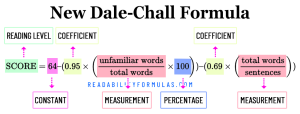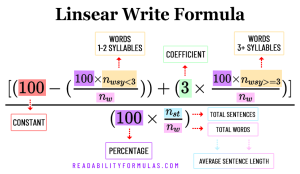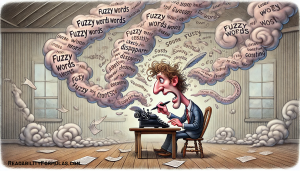Business owners always look for ways to save money and increase profits. One such money-saving measure is to use readability formulas on all text and materials. Readability formulas let you know if your target audience (your customers, suppliers, employees, etc) can read and understand your text. Readable text engages readers and holds their interests. This marriage of mathematics with linguistics may seem unconventional, even bizarre, but these formulas hold a key to saving your company money. Let’s delve into the art and science of it.
The Basics of Readability
Readability is “the ease with which a reader can understand written text.” It is the bridge between the writer’s thoughts and the reader’s comprehension. These formulas analyze text and assign a score that matches with a reader’s grade level. Familiar tools like the Flesch-Kincaid and Gunning Fog Index have long been used by writers to gauge their work’s accessibility.
“In our information-saturated age, time is a very scarce resource. People cannot afford to invest precious minutes attempting to decipher complex text.”—William DuBay, a readability expert.
The Intersection with Business
You might ask, “How does readability translate to financial savings for my company?” The answer rests in how we process what we read.
1. Efficient Communication: In business, time is currency. Documents, whether they are reports, emails, or product descriptions, must be crafted to communicate clearly. Readability formulas help you tailor text to your audience. Readable text reduces confusion and time spent on figuring out poorly written content.
Ben Horowitz, Co-Founder of Andreessen Horowitz: “Poorly written communication is such a significant problem in business that I think it’s worthwhile for everyone who works at a company to become competent at writing.”
2. Customer Engagement: Today’s consumers are discerning and impatient. A complex product description can deter a potential customer. Ensuring that your public-facing materials are readable can increase sales and satisfy customers.
3. Legal Compliance: In some industries, readability is not just a courtesy; it’s a legal requirement. Insurance companies must simplify their policies so the average person can read and understand them. Compliance failures can be costly, both in penalties and reputation. Failure to comply with readability standards can result in fines ranging from $100 to $1,000 per offense (Source: Various State Insurance Regulations).
4. Employee Training: Internal documents must be accessible. Readability formulas ensure employees at various reading levels can understand training materials, reducing errors and the need for repetitive training.
5. Enhanced Marketing Strategies: Readability formulas can help with your company’s marketing strategy. By using the right readability level, you can speak directly to your intended audience. Tailoring your content to engage your readers cuts through the noise of the saturated market, increasing conversion rates without increasing advertising spending.
“In our fast-paced world, the reader’s attention is fleeting. A text that resonates immediately will invariably hold the reader’s interest,” notes Tom Johnson, a renowned marketing strategist.
6. Customer Service Costs: Clearly written instructions, FAQs, and product descriptions can reduce time spent helping customers. When customers can understand information, they’re less likely to reach out for support, which lowers customer service expenses.
7. Content Development: Writers, whether in-house or outsourced, can be guided by readability scores to write content that’s in line with your company’s standards. This ensures uniformity and avoids endless rounds of revisions, thereby producing content faster and reducing costs associated with the creative process.
8. Improving Internal Communication: Miscommunication within a company can lead to costly mistakes. By applying these formulas to internal documents, emails, and memos, employees at all levels can communicate more effectively. This minimizes misunderstandings, hastens decision-making, and saves both time and money.
9. SEO and Online Presence: In the world of online content, readability doesn’t just affect humans; search engines value it too. Well-structured and easily digestible content ranks higher in search results. By leveraging readability formulas, you can enhance your online visibility without investing more in SEO services.
10. Global Expansion: As companies expand globally, the need for clear communication across diverse cultures and languages grows. Readability formulas can guide the editing of content to different reading levels, simplifying translation. The essence of the message remains consistent across languages, reducing the costs of multiple translations and potential cultural miscommunications.
“Language is a complex dance, especially across cultures. Readability ensures that our message remains consistent, irrespective of geography,” asserts Michael Chen, VP of Global Operations at WorldConnect.
How Readability Impacts Businesses
Embracing readability doesn’t mean dumbing down content or erasing complexity. It involves aligning your message with the expectations of your readers. Tools are widely available, from simple online analyzers to integrated software that adapt to your company’s house style. Its potential to unify many facets of business underscores the subtle yet vital role of readability formulas in modern business strategy.
The Cost of Poor Communication in Business
- $62.4 Million Per Year: The average cost of poor communication to companies with 100,000 employees, according to a study by SHRM (Society for Human Resource Management). For smaller organizations, the proportional costs are equally significant.
- 40% Productivity Decline: Employees spend almost 40% of their time clarifying poorly written content, which detracts from more critical tasks, based on research by Harvard Business Review.
The Power of Clear Customer Communication
- 88% of Consumers: A study by Microsoft revealed that 88% of consumers are less likely to return to a website after a bad experience, which includes unclear or hard-to-read text.
- 20% Increase in Sales: Simplifying text has shown to improve online product conversions by as much as 20%, according to Baymard Institute’s e-commerce usability research.
Compliance and Legal Implications
- 30% Savings: Companies simplifying their legal contracts and customer policies report a 30% reduction in litigation costs, according to American Bar Association research.
- $700 Billion Annually: The National Assessment of Adult Literacy estimates this is the cost businesses and governments bear due to low literacy levels among employees and consumers.
Training and Internal Documentation
- 5x Faster Learning Curve: Studies show employees trained with readable and actionable materials learn new tasks 5x faster, leading to quicker onboarding and higher productivity.
The Online Edge
- 53% Bounce Rate: Google data shows 53% of mobile users leave a webpage if it takes more than three seconds to load, compounded if the content isn’t clear.
- 10% Search Ranking Boost: Readable content optimized for user engagement sees a noticeable improvement in search rankings, as noted in Google’s Search Quality Guidelines.
Return on Investment (ROI) of Readability
- $1 Spent, $20 Saved: For every $1 spent improving communication clarity, businesses can save up to $20 in operational inefficiencies, as highlighted by Forbes Insights.
- 50% Reduction in Revisions: Content tailored for readability cuts revision cycles in half, saving both time and money in content production.
Readability and Employee Productivity
- 64% of Employees: According to ClearCompany, 64% of employees believe workplace communication directly impacts their efficiency. Readable internal documents can significantly enhance this communication.
- $37 Billion Annually: Miscommunication in the workplace costs U.S. businesses $37 billion every year, as per a Gartner study.
The Consumer Perspective on Readability
- 90% of Consumers: A survey by HubSpot found that 90% of consumers prioritize clarity over creativity in marketing materials. Clear, concise messaging resonates better and fosters trust.
- 50% of Online Shoppers: According to a Shopify report, 50% of online shoppers abandon purchases because product descriptions are unclear or confusing.
Cost of Legal Compliance
- 25% of Insurance Companies: Data from LexisNexis Risk Solutions shows that 25% of insurance companies fail initial compliance checks due to overly complex policy documents. Simplifying these documents could save millions in fines.
- $3,000 Per Day: Average fines for companies failing to comply with consumer readability standards, according to Consumer Financial Protection Bureau (CFPB) reports.
Training Material Effectiveness
- 60% Reduction in Errors: Readable training manuals result in a 60% drop in workplace errors, according to a National Training Laboratories study.
- 3 Hours Saved per Week: Employees save an average of three hours per week when internal communication and documentation are written at a readability level suited for their comprehension, based on data from Gallup.
Marketing and Conversion Statistics
- 41% Higher Engagement: Readable blog posts and articles increase user engagement by 41%, according to Content Marketing Institute research.
- 72% of Readers: A Nielsen Norman Group study found that 72% of readers prefer content written at or below an 8th-grade reading level, making readability a critical factor in marketing success.
- 3x Higher Click-Through Rates: Marketing emails written at a clear, accessible reading level achieve three times higher click-through rates, based on a Campaign Monitor analysis.
Readability and SEO
- 75% of Users: Research by BrightEdge shows that 75% of users never scroll past the first page of search results. Readability impacts SEO rankings, making it an essential factor for visibility.
- 15% Bounce Rate Reduction: Websites optimized for readability see a 15% reduction in bounce rates, according to a study by Moz.
Financial Impact of Readability
- 20% Faster Decision-Making: Teams equipped with readable reports and summaries make decisions 20% faster, reducing delays and boosting overall productivity, based on data from McKinsey & Company.
- $5.13 ROI for Every Dollar Spent: A Harvard Business Review study estimates that businesses investing in improving readability achieve a return of $5.13 for every dollar spent.
Cross-Cultural Communication
- 42% Fewer Misinterpretations: Using readability formulas to simplify global communication reduces cross-cultural misinterpretations by 42%, as highlighted in a study by Localization Industry Standards Association (LISA).
- 30% Cost Savings in Translation: Readable, simplified source content costs 30% less to translate, according to CSA Research.
Scott, Brian. “How Can My Company Save Money Using Readability Formulas?.” ReadabilityFormulas.com, 12 Dec. 2024, https://readabilityformulas.com/how-can-my-company-save-money-using-readability-formulas/.










